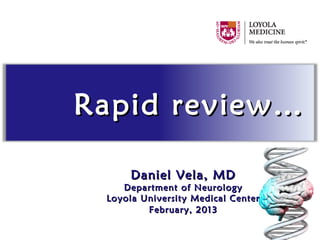
Tetanus-strichnine toxicity & rabies
- 1. Rapid review… Daniel Vela, MD Department of Neurology Loyola University Medical Center February, 2013
- 2. Tetanus • Clostridium tetani • Tetanospasmin: Toxin that interferes with the release of inhibitory neurotransmitter causing excessive excitation of spinal and bulbar motor neurons. • Sustained muscular rigidity and, in severe cases, reflex spasms. – Early manifestations of "The contracted" generalized tetanus are rigidity of the masseter muscles Opisthotonus, By Sir Charles Bell (1809) (lockjaw) and facial muscles, Contracted body of a soldier suffering from tetanus. with straightening of the upper lip or risus sardonicus. • Autonomic instability, mostly hypersympathetic state, may occur in severe cases.
- 4. Management • Metronidazole (500 mg intravenously every 6 hours for 7 to 10 days) • Neutralization of circulating (unbound) toxin by antitoxin will shorten the course of disease and lower mortality. • Human tetanus immune globulin should be administered promptly before manipulating the wound. • The recommended dose is 500 U intramuscularly. • Combined intrathecal (1000 U) and intramuscular antitetanus immunoglobulin administration gives better clinical outcomes than intramuscular administration alone
- 5. Clinical Vignette • A 32-year-old previously healthy male was brought to the emergency room because of difficulty in swallowing and chewing. He reported having been stabbed with a nail at his right foot 7 days previously. He did not receive any antitetanus antiserum or tetanus toxoid. His immunization record showed that he completed primary immunization program during childhood with no booster. The physical examination revealed trismus and rigidity involving facial and trunk muscles. The wound at the right sole was infected. He was diagnosed as having tetanus and was admitted to the hospital. • Human tetanus immune globulin was given intramuscularly. The wound was cleansed thoroughly. Amoxicillin-clavulanate (1.2 g every 8 hours intravenously) and metronidazole (500 mg every 6 hours intravenously) were given and continued for 10 days. Nasogastric tube was inserted. Diazepam was administered intravenously to control muscle rigidity. • Despite such treatments, his condition deteriorated in the following days. Rigidity spread to the limbs and torso. Spasm occurred spontaneously and in response to external stimuli. Rigidity and spasm were severe enough to compromise respiration. Endotracheal tube was inserted while the patient remained relaxed with pancuronium. Tracheostomy was performed thereafter, and respiration was assisted by mechanical ventilator. Pancuronium was given intravenously every 2 to 3 hours and was continued for 4 weeks. Substantial improvement was evident at the end of the fourth week. Rigidity improved, requiring fewer doses of pancuronium. In the sixth week, rigidity was controlled by diazepam alone. He recovered uneventfully and was discharged after 8 weeks.
- 6. Rabies
- 7. • There are two main “phenotypes”: • Encephalitic (furious) 80% – Agitation, delirium, seizures, nuchal rigidity, severe pharyngeal spasms, stridor, autonomic instability, and sometimes hydrophobia or aerophobia. – Symptoms occur approximately 2–10 days after the prodromal period. • Paralytic (Dumb) rabies. 20% – progressive paralysis until death. The clinical course is more indolent, with a clear sensorium sometimes preserved until late in the course.
- 8. Management • Immediate and thorough wound cleansing with soap and water • Human rabies immune globulin around the wound. (20 U / Kg) • Rabies vaccine intramuscularly on Days 0, 3, 7, 14, and 28.
- 9. Strychnine (Nonanticoagulant Rodenticide) Mechanism • Antagonizes glycine, an inhibitory neurotransmitter released by postsynaptic inhibitory neurons in the spinal cord. Binds to the chloride ion channel, causing increased neuronal excitability and exaggerated reflex arcs. Clinical features • Muscular stiffness and painful cramps precede generalized muscle contractions, extensor muscle spasms, and opisthotonus. The face may be drawn into a forced grimace (risus sardonicus, "sardonic grin"). • Muscle contractions are intermittent and easily triggered by emotional, auditory, or minimal physical stimuli. Repeated and prolonged muscle contractions often result in hypoxia, hypoventilation, hyperthermia, rhabdomyolysis, myoglobinuria, and renal failure. • Muscle spasms may resemble the tonic phase of a grand mal seizure, but strychnine does not cause true convulsions, as its target area is the spinal cord, not the brain. The patient is usually awake and painfully aware of the contractions, described as "conscious seizures." Profound metabolic acidosis from increased lactic acid production is common. Management • Airway control, quiet environment (minimize sensory stimulation), and activated charcoal. Avoid lavage (may precipitate seizures). Benzodiazepines, barbiturates, analgesia. Neuromuscular blockage if necessary.
- 10. Strychnine (Nonanticoagulant Rodenticide) Mechanism • Antagonizes glycine, an inhibitory neurotransmitter released by postsynaptic inhibitory neurons in the spinal cord. Binds to the chloride ion channel, causing increased neuronal excitability and exaggerated reflex arcs. Clinical features • Muscular stiffness and painful cramps precede generalized muscle contractions, extensor muscle spasms, and opisthotonus. The face may be drawn into a forced grimace (risus sardonicus, "sardonic grin"). • Muscle contractions are intermittent and easily triggered by emotional, auditory, or minimal physical stimuli. Repeated and prolonged muscle contractions often result in hypoxia, hypoventilation, hyperthermia, rhabdomyolysis, myoglobinuria, and renal failure. • Muscle spasms may resemble the tonic phase of a grand mal seizure, but strychnine does not cause true convulsions, as its target area is the spinal cord, not the brain. The patient is usually awake and painfully aware of the contractions, described as "conscious seizures." Profound metabolic acidosis from increased lactic acid production is common. Management • Airway control, quiet environment (minimize sensory stimulation), and activated charcoal. Avoid lavage (may precipitate seizures). Benzodiazepines, barbiturates, analgesia. Neuromuscular blockage if necessary.
